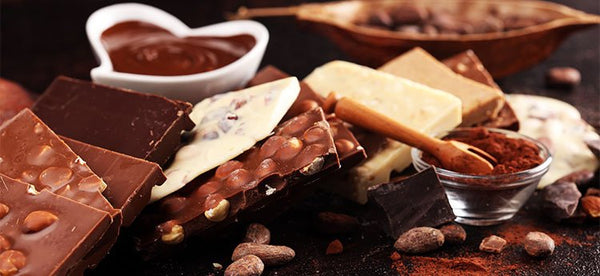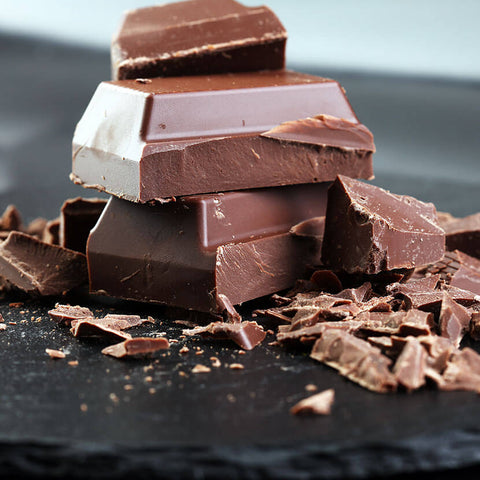There are many types of wine and spirits that can go in love and agree with chocolate; however, it is not easy to find the right combinations, but with the right attention and some experimentation, you can have great satisfaction.
Before entering the world of the right wine-chocolate combination, let's take a step back and go back to antiquity to see the origins and some curiosities about this extraordinary food. Chocolate is a food derived from the seeds of the cocoa tree; we are talking about a fantastic product, a unique delicacy that has great properties, it is also capable of delighting the senses, cheering up the mood and uniting the most diverse palates. A substance contained in cocoa is phenylethylamine (the same that the brain releases during falling in love) as well as a small percentage of caffeine; these make chocolate an energizing food, capable of "put you in a good mood", protect against cardiovascular problems and fight bad cholesterol.

Archaeological studies have found traces of cocoa in some bowls of old civilizations in the territory of South America, present-day Ecuador. Mexico was its cradle, the first peoples who recognized the preciousness of this food were the Maya who then handed it down to the Aztecs, who exploited this plant obtaining a drink that they believe possessed magical powers. An infusion of crushed broad beans called "xocolatl" to which they added spices, this was offered to the gods during the rituals for propitiatory requests. The Aztec people used cocoa beans as a bargaining chip or as a means of buying food, satisfying carnal pleasures or buying slaves.

Cocoa was known in Europe only after Christopher Columbus discovered America and more precisely on July 30, 1502, when the Aztecs going to meet the third caravel, the Santa Maria, offered Columbus in addition to leather and fabrics, also their currency: "cocoa almonds". This offer, however, new and unknown to them, was not appreciated and was not given any importance, Columbus still decided to bring some seeds to the Spanish court. From the coasts of the new world, in 1528, the first transoceanic cargo left for the old continent towards Spain, from that moment the centuries-old Spanish monopoly on cocoa began.

In 1600 Louis Xlll of France and Princess Anne of Spain joined in marriage; among the habits that the bride brought to the French court there was also that of consuming a infusion prepared by boiling the chopped beans in water with the addition of sugar and other ingredients to taste such as almonds, pepper or chilli. From France to the rest of Europe it was a short step, and one of the nations where cocoa found immense success was Italy. He arrived at the Medici Court in Tuscany, where he was immediately much appreciated and in the kitchens embellished with spices, fruit and flowers, however, it was chocolate-jasmine that had the greatest success. Piedmont was proclaimed the Italian capital of chocolate in the 17th century; Giovanni Battista Ari was granted the first license to open a chocolate shop in 1678, but it was towards the end of the 1700s that the processing of chocolate took a big step forward and began to solidify. Towards the nineteenth century the production of the first experimental chocolate bars began and, in the space of twenty years, the first "chocolate shops" opened in the "trendiest" cities and invented Gianduia chocolate.

Many other countries got busy with inventiveness so much that in the same years, in Switzerland, they began the production of milk chocolate, and in 1912 in Belgium Jean Neuhaus invented chocolate pralines. Europe was literally attracted to the charm of chocolate, and also in England, where this exceptional ingredient arrived later than in other nations, chocolate was drunk in special "chocolate drinking houses".

The cocoa plant (Theobroma cacao) is an evergreen umbrella tree of the Sterculiacee family, producing an average of twenty to fifty fruits every year. The pods (cabossides) are oval in shape and within them are hidden from twenty to forty precious cocoa beans, the important seed from which the particular processing chocolate derives. Once removed from the cocoa beans, they are fermented and then hung out to dry in the sun, after which they are ready to be processed. To date, the great world production of cocoa trees has extended to 70,000 sq km, divided between the countries of the world with the most suitable climate for its cultivation. Africa is the first cocoa producing continent in the world, the main crops are located in: Cameroon, Congo Nigeria and Ivory Coast. In second place we find Central and South America with Mexico, Colombia, Venezuela, Ecuador and Brazil; Asia follows with Indonesia and Sri Lanka.

To obtain the cocoa paste it is first necessary to carry out a first grinding of the dried seeds, this is initially done coarsely and then finer; The result is a dough that can become liquid and buttery until it solidifies, this varies according to the temperature in which the fattest part, the cocoa butter, is found.

The cocoa butter is extracted from the ground seeds with the aid of presses whose extraction determines the sensation of meltness of the chocolate, given by the percentage of cocoa butter that is left there. The cocoa powder is obtained from a further and very fine grinding of the beans which is carried out once the cocoa butter has been eliminated. Dark chocolate must contain a minimum of 43% cocoa mass, while the extra dark chocolate must be around 85-90%. Milk chocolate is the most consumed in the world and is obtained by adding powdered milk to cocoa mass, as well as sugars, fats and cocoa butter. White chocolate is not a real chocolate, as its ingredients are only cocoa butter with added milk.

And now that we have learned how chocolate is born and the types that we can find on the market, let's try to understand which wine-liqueur to combine it with. In addition to the characteristics of the individual types, attention must be paid to the type of processing to which the chocolate is subjected and to any spices, fruits and added aromas. Each chocolate has a more or less high percentage of cocoa butter inside, the patinated sensation it leaves can make it difficult to match. It also seems that the higher the percentage of cocoa, the higher the structure of the wine must be, so that the sweetness can be balanced with the bitter, and the acidity with the spice of the chocolate to make the flavors more elegant. There are many supporters that the best combinations to sip with the various types of chocolate are with the historic evergreens: Cognac, Whiskey, Brandy and Vermouth. However, we want to offer you some unusual combinations, certain that among our proposals you will surely find something that meets your tastes to best match this amazing combination of chocolate and wine-liqueur.

PAIRING WITH DARK CHOCOLATE
Every time you taste dark chocolate you will fully perceive all the authentic taste of cocoa, the real one, dry and direct, tannic, with a fantastic bitter aftertaste and a great and delicious aroma. The most popular and also the most classic combination is the one with passito or sweet wines in general, this is because this type of drink helps to soften the impact of the strong taste of cocoa and the alcohol content combined with sugar, and favors the enveloping taste. The ideal combination should cleanse the palate, in order to accommodate the new entrance of the chocolate.
Below we have proposals based on balsamic, spices, and even more decisive tastes, and therefore we suggest you taste the finest dark chocolate in combination with:
-
Grappa Riserva La Speziata Sibona Distillery: a distillate characterized by hints of cinnamon and nutmeg; it enters the mouth with a soft, enveloping and delicate flavor that in the finish gives a very persistent fragrant taste of ginger and cloves.
-
Formidable bitterness: an excellent natural liqueur, handcrafted, with various herbs and spices left to cold macerate in wheat alcohol; with its spicy and woody flavor it is perfect to combine with dark chocolate.
PAIRING WITH MILK CHOCOLATE
This type of chocolate is the most popular in the world, and has a sweeter and more persistent taste due to a greater presence of sugars and cocoa butter inside. Usually the first scent that is perceived is slightly caramelized, and then gradually turns into the hint of milk and cocoa. On the palate it is characterized by its greater sweetness and its particularly intense milk flavor.
With these characteristics, the wines to be paired with milk chocolate can be chosen both for their sweetness and for a slightly drier taste or with the right degree of acidity such as:
-
Moscato di Sicilia Cantina Martinez: a Sicilian fortified wine based on Moscato di Alessandria, which with its fruity and citrusy sweetness balances the fatness of the chocolate and gives an amazing taste.
PAIRING WITH WHITE CHOCOLATE
White chocolate, previously defined as a "false chocolate", is obtained from the processing of cocoa butter; it is a type that contains a lot of fats and has an almost buttery consistency, a very sweet taste and a vanilla aftertaste.
It can be paired with sweet and flavored wines, or with a tasty bubble to cleanse the mouth:
-
Ice Wine Liliac & Kracher a sweet wine but at the same time with the right level of acidity, it supports the creamy structure of the chocolate and gives the palate an enveloping and satisfying taste.
-
Malvasia Cantina La Ratta a sweet and sparkling white wine, pleasantly fruity, very pleasant and fresh, with a harmonious and persistent finish.
We have shown you just some of the possible combinations with chocolate, now it's up to you to decide which combination is closest to your tastes.


























